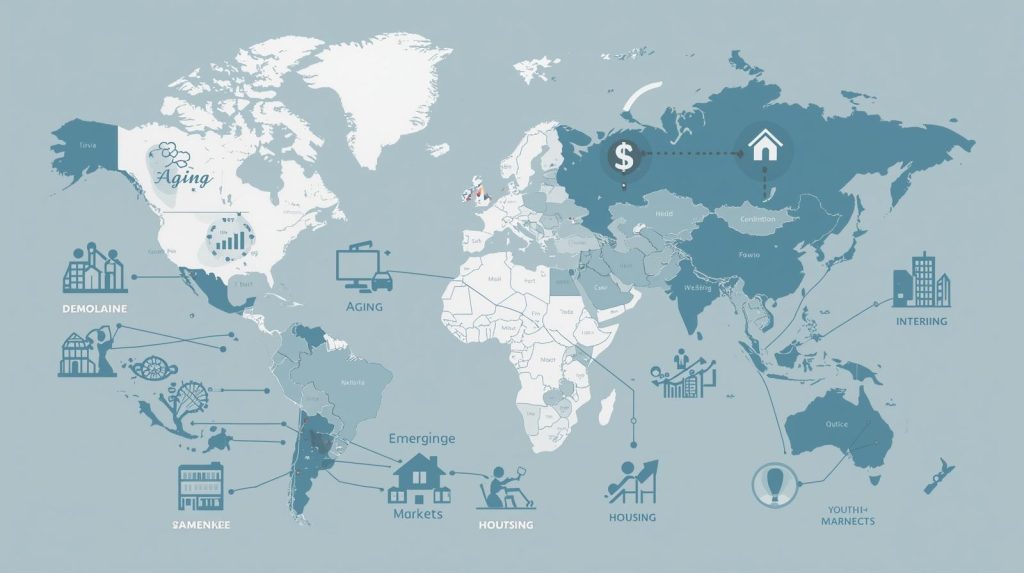
Why Demographics Matter in Investing
Markets move not only because of earnings reports or interest rates but also because of long-term demographic forces. Demographic shifts—such as aging populations, urban migration, and generational changes—directly shape consumer demand, labor markets, and government policies.
For everyday investors, understanding these demographic megatrends provides an edge. Instead of chasing short-term market noise, you can align your portfolio with predictable, long-term human behavior.
Key Global Demographic Trends in 2025
Aging Populations in Developed Markets
Countries like Japan, Germany, and the United States are seeing record numbers of retirees. This shift increases demand for healthcare, retirement services, and stable income-generating assets.
Youthful Populations in Emerging Markets
In contrast, nations like India, Nigeria, and the Philippines boast young, growing populations. Their expanding middle class drives demand for education, technology, housing, and consumer goods.
Urbanization and Migration Patterns
More people are moving into cities, particularly in Asia and Africa. Urbanization creates opportunities in infrastructure, real estate, and digital connectivity while straining traditional resources.
How Demographics Influence Investment Opportunities
Healthcare and Biotech
As populations age, demand for healthcare services, pharmaceuticals, and biotechnology solutions continues to rise. Companies specializing in elderly care, medical devices, and chronic disease treatments stand to benefit. For investors, healthcare ETFs and biotech funds provide diversified exposure to this theme.
Technology and Digital Services
Young populations in emerging markets are digital natives. Their adoption of e-commerce, mobile banking, and digital entertainment is fueling growth for tech firms. Everyday investors can access this trend through ETFs focused on emerging markets technology or global internet companies.
Housing and Real Estate
Urban migration creates significant demand for housing, commercial property, and infrastructure. In developed nations, retirement communities and assisted living facilities are growth areas, while emerging markets focus on affordable housing and urban expansion.
Consumer Goods and Lifestyle Industries
Generational preferences matter. Millennials and Gen Z value sustainability, experiences, and digital convenience. Companies aligning with these values—from sustainable fashion to plant-based food—are positioned for growth.
Risks and Challenges of Demographic Investing
While demographic trends are powerful, they are not without risks:
- Policy changes: Governments may alter retirement ages, healthcare funding, or immigration rules.
- Economic shocks: Recessions or geopolitical conflicts can disrupt demographic-driven growth.
- Overvaluation: Popular demographic themes may lead to bubbles if investors chase them blindly.
The lesson: demographics provide direction, not timing.
Practical Strategies for Everyday Investors
ETFs and Funds Targeting Demographic Themes
Investors don’t need to pick individual companies. Thematic ETFs—such as those focusing on aging populations, healthcare innovation, or emerging market consumers—offer diversified exposure.
Balancing Short-Term Cycles with Long-Term Shifts
Demographic investing works best with patience. While short-term volatility may shake markets, long-term population trends remain steady. Investors should use demographics as a compass while maintaining diversification across assets.
Final Thoughts: Investing with a Demographic Lens
Demographics are destiny. Aging populations will continue to reshape healthcare and retirement industries, while youthful emerging markets drive technology and consumer growth.
For everyday investors, recognizing these trends provides clarity in a noisy market. By aligning portfolios with long-term demographic shifts, you’re not just chasing the latest stock fad—you’re investing in the future of humanity itself.
Leave a Reply